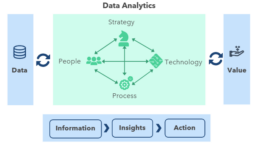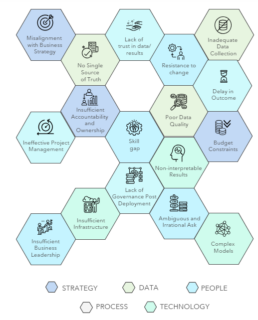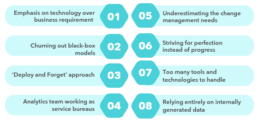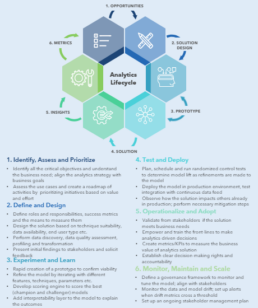The ROI Challenge
“Only 10% of firms gain significant financial benefits from Artificial Intelligence” – MIT Sloan Management Review
When the economic crisis from the 2020 pandemic struck, many leaders struggled to mine – or even access – their data for critical decisions. This situation, with its wide scale and acute importance, exposed a serious issue — Too many firms have built analytics capabilities based on technological possibilities – not fully set up to solve real world business problems.
While investments in analytics are booming, many firms aren’t seeing the ROI they expected. They struggle to move from employing analytics in a few successful use cases, to scaling it across the enterprise, embedding it in organizational culture, and everyday decision-making. Advances in cloud data infrastructure have made it easy to store and access data, but this rapid advancement was accompanied by a plethora of new tools that have inadvertently caused data chaos.
The progress in these new-age tech solutions has not been matched by people and processes. Hence a lot of the developed data and analytics have ended up sitting on shelves. A recent survey1 reported that only 26% of the organizations have met most of their AI operationalization goals over the past year, and just 5% have hit them all.
Experts can tout the benefits of being data-driven, but insights remain worthless until they are acted upon. In addition, the timing of the action is equally important since the value from any insight decays rapidly over time. To maximize the return on data-related investments, companies need to be both data-driven and action-agile. This requires a system approach to turn more insights into actions, overcoming all roadblocks in the way.
This paper talks about the:
1. Value firms should aim to derive from their analytics investments,
2. Factors that prevent realization of such tangible benefits,
3. Guiding principles to help put focus back on monetization of analytics investments.
Business Purpose of Analytics
Strategic assets are defined as capabilities and resources that have a meaningful contribution to the value of a business. This business value can be measured using financial metrics such as revenue and costs, or qualitative measures such as the customer experience and brand value.
For several years, it has been said that “data is the new oil” and arguably, the most valuable strategic asset for a business. Whilst getting value out of data might be less straight-forward, it is true that data needs to be refined to make it valuable. Using your data to enhance customer experience, develop new products and intellectual property, and ultimately grow the value of the business is the true purpose of data analytics; We refer to this journey as Analytics Monetization.
The process of analytics monetization comprises:
1. Parsing and structuring of data to create valuable information
2. Deriving insights from this information to create opportunities
3. Operationalization of insights, as actions, creates tangible economic value
Firms can fulfill the business purpose of analytics by balancing people, process, technology, and strategy, and optimizing the relationships between them.
Exhibit 1. Analytics as an Instrument to Create Value from Data
What Impedes 'Monetization'
In our experience, several factors cause analytics initiatives to be stuck at experimentation phase or fail to generate tangible business outcomes after deployment:
STRATEGY
- Misalignment with Business Strategy
The objective of any analytics effort must be to answer business critical questions needed to define or implement the company strategy. If all impacted departments, together with the analytics team are not aligned on the details of the strategy, the insights and actions produced will not be aligned with funded implementation programs.
- Insufficient Accountability and Ownership
A lack of accountability can kill any project. Analytics initiatives usually involve participants from various teams such as IT, analytics and various business lines. In any cross-functional team with a potential mismatch of expectations, or not having a clear owner dedicated to and accountable for the success of the program typically leads to unfocused outcomes.
- Budget Constraints
Process advancements come at a cost. Most analytics initiatives require investment in new data collection, technology upgrades and analyst hours. Failure to plan for the full scope of investments often ends up with compromised delivery.
Exhibit 2. Factors that hinder business value creation from analytics
DATA
- Inadequate Data Collection
Any model is as good as the data that trains it. For a model to help with future decisions, it needs to be told accurately and exhaustively what past actions have delivered. Firms need to first make sure they are collecting enough data for their models to learn and predict.
- Poor Data Quality
While the adage “garbage in garbage out” has become a cliche, it remains a live challenge when implementing AI and analytics. Clean, machine learning-ready data is a prerequisite for AI and analytics projects.
- No Single Source of Truth
Having multiple (or zero) versions of the truth is one of the most common problem organizations face. It is not that firms don’t have data, but rather that they don’t properly marshal data into an environment where it can be analyzed and modeled.
PROCESS
- Ineffective Project Management
Without established and clear methodologies designed for analytics project management, organizations often resort to ill-suited project management practices, leading to inefficient information sharing, missed steps, and misinformed analyses. -
. Dearth of Near-term Outcomes
Often analytics transformations can go on for a while without achieving tangible results. Such planning drastically reduces the chances of success. Timely delivery of insights usually gets turned into action; delays can cause irrelevance and may result in loss of stakeholder interest. -
Lack of Governance Post Deployment
Models do not perform with same accuracy forever. Because models are built to learn as they run, they can unintentionally develop biases if they are supplied with data that could cause one. Such biases can alter the model’s decisions in the future and its perception of being reliable. -
Lack of trust in data/results:
With wide proliferation of big data, the probability of having quick access to large volumes of data is high. However, the data governance processes of many organizations are not yet equipped to trap the inaccuracies in the data which may result in misleading diagnoses and inaccurate predictions, leading to business users eventually losing trust.
PEOPLE
- Skill Gap
Lack of relevant knowledge and hands-on experience with similar transformations is also a common cause for failure. Even with an abundant supply of skilled data scientists, firms find it difficult to find and retain resources with the right mix of technical and business knowledge.
- Resistance to Change
Analytics often uncovers inconvenient truths. In addition, organizations may have conflicting priorities. This makes new initiatives highly vulnerable in their early stages. If not nurtured carefully, analytics transformations are easily orphaned.
- Ambiguous and Irrational Ask
Many analytics projects fail due to a lack of explicit and agreed upon goals; users of analytics may not be aware of what is possible or potential trade-offs, so may not be specific and realistic enough in their ask, and the supplier (internal or external) is often left guessing.
- Insufficient Business Leadership
Without direction and leadership by the business, it’s easy for a data analytics projects to veer off course, burning time and budget. Not every analytics implementation goes according to plan, and this can cause business leadership to lose enthusiasm over time.
TECHNOLOGY
- Complex Models
Often data scientists are lured into building complex models where a simpler one may suffice, or at times be even superior. Such choices not only distract from the goal at hand but may make the analytics less repeatable, maintainable or understandable by the business.
- Non-interpretable Results
Statistical performance metrics or predictive scores are an incomplete description of most real-world tasks. Business leaders need to know why they are being advised to take the recommended action. Data-driven outputs that fail to provide the supporting rationale often get rejected by the users.
- Insufficient Infrastructure
As the universe of data expands, the technologies required to manage and make sense out of the data need to advance as well. Firms often attempt to solve big data problems using traditional data technologies, in which case failure is more than often certain.
Exhibit 3. Proven ‘Recipe for Failure’ in Analytics
Put Focus Back on Creating Value
Despite their efforts — to hire data scientists, develop algorithms, and optimize processes and decision making — most companies aren’t seeing a significant return on their investments. There is often a need to go back to the drawing board and rethink the approach to deriving most business value out of data. Some guiding principles for a proven analytics monetization approach are defined next.
- Purpose driven analytics helps teams stay focused on creating business value. Data analytics leaders should work more closely with the business to align data goals with enterprise investments. Leaders need to build a term-wise roadmap of their analytics to ensure effective oversight. Following a purpose-driven approach improves user adoption and reduces the chances of analytical models sitting on shelves.
- Aligned upon definition of success and KPIs at the onset make sure that all members are working towards common goals and standards. Analytics specialists are typically used to evaluating their work through statistical metrics that are often unappreciated by business stakeholders, until it is translated into tangible business outcomes. Alignment on “What success looks like?” bridges the perception gap, ensures realistic targets, and prevents last-minute surprises during delivery.
- Democratize analytics with interpretable AI to allow the business to easily make sense of the diagnostics and recommendations produced by the analytics solutions. In industries such as healthcare, where questions of accountability and transparency are particularly important, if analytics leaders are unable to deliver interpretability and explainability of their algorithms, it limits the potential application and benefits from AI.
- Continuous maintenance and improvement of your analytics capabilities. As revolutionary as AI/ML is, it is still in its early developmental stages compared to the traditional software products. We have still not perfected AI and so, it needs to be checked regularly to see if it is making the right decisions. For example, before COVID, a model could accurately predict the footfall in hotels based on historical data but post COVID, that model may no longer make sense. Compliance and reputation management are two other reasons to invest in governance and monitoring of analytics assets.
- Tighten the loop between data and action One of the common examples of a closed-loop data process is the marketing-sales loop. Feedback on closed sales back to marketing helps with tighter sales and marketing alignment. It enables marketing to keep refining their campaigns to achieve higher conversion rates. Setting up a similar closed loop between action and data enables analytics teams to continuously enhance their models and plan for new data collection. If the models stay updated with the insights post-implementation, they tend to not lose relevance.
- Extending agile approaches to analytics Most of the analytics project failures are attributed to user dissatisfaction. One of the basic principles behind Agile is that if analysts continuously adapt their applications to align with user expectations, users will be satisfied with the outcome. Agile is a style of building applications that focuses on the early and continuous delivery of business value throughout the development lifecycle. Such an approach automatically places the responsibility of success equally on the users, stakeholders, and developers and rewards adaptability. “It is better to fail fast and adapt than to fail late when you have no time to go back.”
- Build AI teams with more than just data scientists When building the data science teams, firms are eager to hire data scientists. The role of a Machine Learning Engineer has also started to become mainstream as they package the model into an end-to-end application. However, some other roles are often missed, such as analytics translators, data storytellers, and even behavioral psychologists. These team members act as the bridge between engineers and business users by facilitating smooth exchange of information in a manner that the business users understand.
- Leverage the power of cloud analytics Using cloud analytics makes implementation, management, accessing analytics, and getting feedback easier for everyone. A significant amount of time is saved with quick deployment, hassle-free software updates, flexible data storage and compute power etc. It also makes scaling way more affordable as most of the cloud-based systems work on pay-as-you-go model.
- Standardizing the analytics operating model. A strong operating model is a consistent way of grounding and stabilizing benefits from advanced data science. Regardless of whether you chose a centralized hub-and-spoke model or a federated model, it is important to have defined working standards, technology stack, and documentation guidelines for the entire team. A standard set of practices makes the deployment quicker, fosters accountability and optimizes the use of talent and resources.
Exhibit 4. Framework for Analytics Monetization
In Closing ...
“Information is the oil of the 21st century and analytics is the combustion engine.” – Former Senior Executive, Gartner Research, 2011
As businesses increase investments in data and analytics, the need to have a result-obsessed approach becomes vital. The importance of strategy, people and processes in achieving the desired results is often overlooked, which leads to projects failing or stalling at development stage.
This paper talked about causes for not realizing the full benefits from analytics investments and some guiding principles that can pave the path to success.
In summary:
1. Every data analytics project should be tied to a business purpose that’s aligned with firm’s strategy
2. Analytics solutions should consistently generate actionable insights for business
3. Business users should be on board and in close collaboration, with clear accountability, from day 1
The root causes and guiding principles in this paper summarize more than a decade of experiences with successful execution of analytics-based business transformation.
__________________________________________________________________________________________________________
- From VAR To Solution Provider, Computer Economics, Avasant Research































